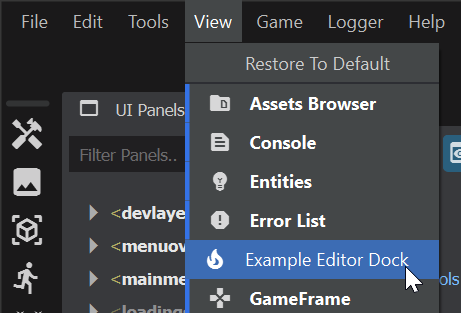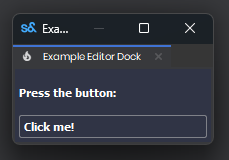Editor UI is built entirely out of Widgets. Widgets are different from Panels, which are used for in-game UI. Widgets can be various elements or components, such as labels, buttons, text boxes, trees, or images.
If a Widget does not have a parent, it is a Root Widget. This Widget will act as a window on the user's OS.
Creating a Widget
Each Widget has a Layout, which can contain child Widgets or sub-Layouts. Widgets can also be styled with CSS similarly to Panels.
public class ExampleWidget : Widget
{
public ExampleWidget(Widget parent) : base(parent, false)
{
// Create a Column Layout
Layout = Layout.Column();
// Give it some Margins/Spacing
Layout.Margin = 4;
Layout.Spacing = 4;
// Apply some CSS styling
SetStyles( "background-color: #303445; color: white; font-weight: 600;" );
// Add some child Widgets to the Layout
Layout.Add(new Label("Press the button:", this));
var btn = Layout.Add(new Button("Click me!", this));
btn.Clicked += () =>
{
Log.Info("You did it!");
};
}
}
You can now create this Widget anywhere else in your Editor Project by doing the following:
// Creates the Widget as a new Window since it has no parent
var windowExample = new ExampleWidget(null);
windowExample.Show()
// Creates the Widget as the child of another Widget, then adds it to that Widget's Layout
var childExample = new ExampleWidget(parentWidget);
parentWidget.Layout.Add(childExample);
Creating a Dockable Widget
Creating a Widget with the [Dock] attribute will allow it to be docked within any DockWindow. It will also be added to the View menu so it can be toggled easily.
[Dock("Editor", "Example Editor Dock", "local_fire_department")]

Creating an Asset Editor
Including the [EditorForAssetType] attribute will open your widget upon double-clicking the specified asset. Doing this will invoke AssetOpen() on your Widget through IAssetEditor so you can get any Asset information.
// Supply the file extension of the asset, cannot be more than 8 characters
[EditorForAssetType("item")]
public class ItemEditorExample: Window, IAssetEditor
{
// Return false if you want the have a Widget created for each Asset opened,
// Return true if you want only one Widget to be made, calling AssetOpen on the open Widget
public bool CanOpenMultipleAssets => true;
Asset MyAsset;
ItemResource MyItem;
Label MyLabel;
public ItemEditorExample()
{
// Cannot modify the Layout of a Window, instead we have a Canvas Widget
Canvas = new Widget( null );
Canvas.Layout = Layout.Column();
Canvas.Layout.Spacing = 8;
Canvas.Layout.Margin = 8;
MyLabel = Canvas.Layout.Add( new Label( "", this ) );
var btn = Canvas.Layout.Add( new Button( "Reset Name", this ) );
btn.Clicked += ResetName;
Show();
}
// From IAssetEditor
public void AssetOpen(Asset asset)
{
// Get the Resource from the Asset, from here you can get whatever info you want
MyAsset = asset;
MyItem = MyAsset.LoadResource<ItemResource>();
MyLabel.Text = MyItem.Name;
// If CanOpenMultipleAssets returns true, you should refocus this widget
Focus();
}
// From IAssetEditor
public void SelectMember(string memberName) { }
void ResetName()
{
// If we modify the Resource at all, we can save those changes with SaveToDisk
MyItem.Name = "N/A";
MyLabel.Text = MyItem.Name;
MyAsset.SaveToDisk(MyItem);
}
}
Created 10 Oct 2024
Updated 10 Nov 2024
